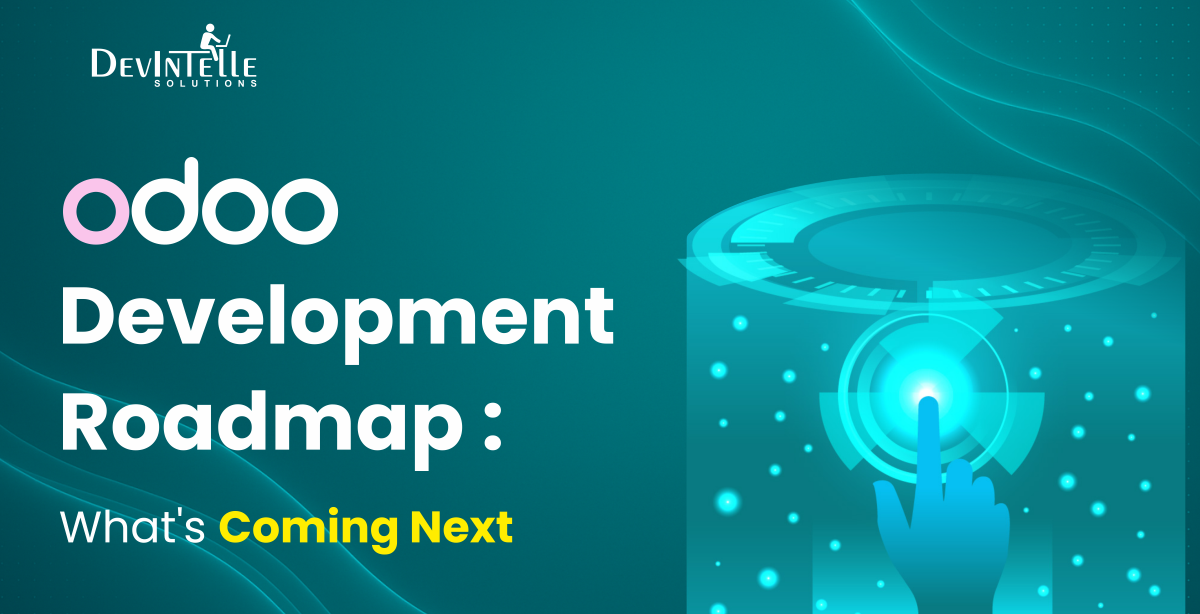Odoo has travelled a long distance from being an open-source ERP platform to a full-fledged business app suite utilized by businesses globally. With every release, it is becoming faster, smarter, and more user-centric. The thrill, however, lies in what's yet to come.
In this blog, we're going to walk you through the future of Odoo development, the newest additions, and plans. Whether you're a developer, a business owner, or a curious learner, this tutorial will give you a clear picture of the shifting Odoo ecosystem.

1. Simpler and Smarter User Experience
Odoo has been constantly improving its user interface. Recent versions focused on making the platform more beautiful and easier to use. Keyboard shortcuts are now available, dashboards are better organized, and everything loads faster, even on mobile devices.
The roadmap shows even more effort toward better onboarding. For example, first-time users will get easier access to tips, helpful popups, and simplified screens. The goal is to reduce training time and help users feel comfortable from day one.
You can also expect more Progressive Web Apps (PWA) support, which means certain modules like Barcode, Point of Sale, and Attendance will work just like mobile apps, without needing Play Store or App Store downloads.
2. Business Apps With Real Impact
The business side of Odoo is growing rapidly. One major update is the introduction of native sales commission tracking. Sales managers can now set monthly or quarterly targets, monitor performance, and reward top performers all without third-party apps.
Quote templates are also smarter. Now you can build a professional quote in PDF, set up combo products (like bundles), and allow customers to interact with the document, let them pick what they prefer, and finalize the transaction in fewer steps.
In short, Odoo is no longer merely a tool to manage your sales but a system that proactively aids you in closing more deals.
3. E-commerce and Website: Built for Conversion
For online sellers, big changes are underway. A new checkout experience reduces steps by combining everything on a single page. Features like "login during payment," map-based pickup locations, and better coupon handling are all part of making the buying process frictionless.
Menus and SEO have also improved. Mega menus make it easier to organize content, and the system now helps you manage keywords and meta tags, making your site more visible on Google.
From catalogue browsing to delivery, the full customer journey is becoming smoother and faster.
4. Inventory, Manufacturing & Barcode
Warehouse teams will love the latest improvements in inventory and scanning. The barcode app now works on mobile and includes smart scanning, error sounds, and serial number tracking.
Shipping integrations are tighter with FedEx, DHL, and UPS. And now, if you're using multiple warehouses, you can control product flows between locations in batches visually.
In manufacturing, the planning view is more dynamic. You can drag and drop tasks, add notes to assembly steps, and perform quick quality checks during production. These are practical tools that save time on the factory floor.
5. Financial Management Grows Smarter
One of the biggest shifts in recent versions has been how finance works. The reconciliation process is now visual, using kanban cards and smart suggestions. Anomalies in invoices are detected automatically, reducing errors.
The accounting module now handles multi-currency even better and integrates well with major banks and credit card systems.
You can also generate advanced reports, track asset depreciation, and work across multiple companies, all from the same system.
6. People & HR Tools
The HR suite keeps getting better. Hiring managers can now use resume parsing to filter candidates by skill sets. Workers can view their leave history, report their timesheets, and even clock in through fingerprint.
Managers can also establish approval flows for expenses, leave, and lunch orders. The intention is obvious with a focus on paperless processes, more automation, and smarter people management.
7. Helpdesk, Chat & AI Support
Customer support is receiving a big boost. The helpdesk module will now suggest solutions based on past tickets and documentation. This means fewer repetitive questions for your agents and faster support for your customers.
Live chat and email inboxes are also getting smarter, with better filters and tagging systems to reduce confusion and improve team response times.
AI is starting to show up in small but powerful ways, such as lead scoring, auto-translation, and smart suggestions for responses.
8. Marketing: Reach More, Do Less
Odoo now makes it easier to send campaigns over WhatsApp, email, and social media, all from one screen. You can design a post, schedule it, and even track how many people engaged with it.
One of the latest additions is a social share application, enabling you to post to sites such as Facebook and LinkedIn with a single click.
Coupled with automation rules and insights, this enables small teams to accomplish great things.
9. The Studio Platform & Customization
For those who like to build their workflows, Odoo Studio is becoming more powerful. You can now design custom dashboards, add AI fields, and even create smart buttons that act based on natural-language prompts.
Spreadsheets now have chat-like collaboration and the ability to import dynamic charts and graphs. These are major improvements for users who depend on reports and data to run daily operations.
10. What's Next in Future Releases?
Looking ahead, the roadmap suggests that the next big shift will be AI-powered ERP.
Imagine typing:
"Show me the top 5 customers with unpaid invoices this month and draft a reminder email."
…and the system just does it.
That's what future versions aim to achieve.
Features like server actions powered by prompts, Artificial intelligence module assistants such as CRM or HR, and automated generation of insights will probably be a significant aspect of the future wave.
It's not about replacing individuals, it's about enabling them to make smarter decisions, quicker.
Conclusion: Why It Matters for You
In the future, it's obvious that Odoo is not simply adding features and buttons; it's creating an intelligent platform that evolves with your business.
Every module is becoming more integrated, user-friendly, and smarter. Whether you're managing customers, inventory, accounting, or marketing, everything is being designed to save time and increase productivity.
And if you are wondering how to make the most of all these upgrades, that's where Devintellecs comes in.
We're not just an Odoo development company; we are your trusted partner in digital transformation. From implementation to customization, we help businesses like yours grow faster, work smarter, and deliver better results.
💬 Ready to take your ERP to the next level?
📧 Drop us a line at [email protected]
🌐 Explore more at devintellecs.com

